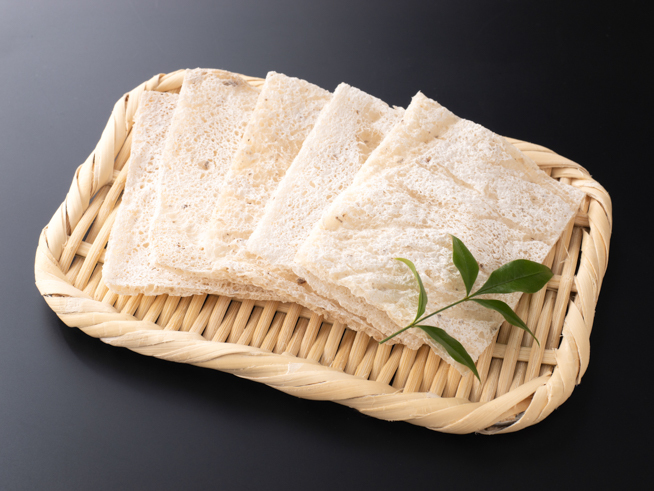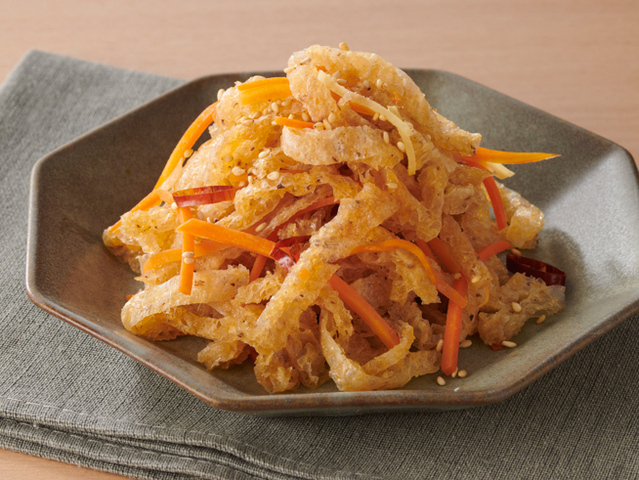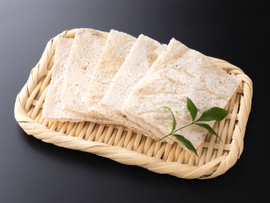Shimi Konjac | Traditional Foods in Japan

Shimi Konjac

IbarakiShimi Konjac
Classification (Large)
Agricultural products
Classification (Small)
Other processed agricultural products
Main ingredients used
konjac
When using downloaded images, please read the "Terms of Use" and clearly state that the source of the image is "Traditional Foods in Japan" by the Ministry of Agriculture, Forestry and Fisheries.
If the photo credits is stated, please include it as well.
Example of description
of the photo credits
Example of description when the photo credits is not stated
Source: "Traditional Foods in Japan" Ministry of Agriculture, Forestry and Fisheries Example of description when the photo credits is stated
Source: "Traditional Foods in Japan" Ministry of Agriculture, Forestry and Fisheries
Photo credits:xxx
Region of inheritance
Northern region (Daigo Town, Hitachi-Ota City, etc.)
Product overview (special characteristics and types)
Shimi Konjac (Frozen konjac) is a traditional food made by laying out thinly sliced konjac on straw that has been spread in fields during the coldest periods in winter. Water is applied to the konjac, which is repeatedly frozen and thawed to remove moisture. The finished konjac soaks up soup broth like a sponge, giving it a unique texture and making it a tasty addition to any. Shimi Konjac is generally used in nishime, but in recent years it has been used in various other dishes as well, including deep-fried ones. As Shimi Konjac is low in calories and high in dietary fiber and calcium, it is also becoming popular as a health food.
History and culture
Konjac potatoes have long been cultivated as a major crop in northern Ibaraki Prefecture, and this region is said to be the birthplace of konjac.
It is said that the in the mid-Edo period, Toemon Nakajima, a farmer from the city of Hitachi-Omiya (formerly Morosawa Village, Kuji County) invented a manufacturing process for konjac potatoes, which took much time and effort to produce, ship, and distribute. His process had konjac potatoes sliced and dried during winter days and turned into powder. This enabled long-term storage and distribution to distant locations, and konjac became the exclusive product of the Mito clan, supporting the clan’s finances. In recognition of his achievements, the Mito clan allowed Toemon to have a surname, carry a sword, and don hemp ceremonial wear.
The manufacturing method for Shimi Konjac is said to have been brought from Tamba by Kenji Kimura, an explorer from the city of Hitachi-Ota (formerly Kegano Village, Kuji County), in the late Edo period, and it became a side business for off-season farmers in northern areas of Ibaraki Prefecture, where konjac production was popular. Nowadays, Shimi Konjac has become a rare foodstuff manufactured at only a few farms in this part of Japan.
Production method
Shimi Konjac is produced in dry regions with dramatic temperature differences and no snowfall, which is characteristic of the climate in mountainous areas. During the coldest winter months of mid-December to February, straw is laid out in fields on which thinly sliced, postcard-size pieces of konjac are placed by hand, each to be painstakingly watered to freeze overnight. The konjac is repeatedly frozen at night and slowly thawed during the daytime for 20 days, with the timing of drying and amount of water used adjusted according to the weather. This dries the konjac into a sponge-like consistency, after which it is thoroughly dried for one more week to create the finished product. It has an extremely long shelf life and is said to last for many years in its dried state.
Conservation and succession efforts
Daigo Town is the home of konjac Shrine, dedicated to Toemon, where until recent years the konjac farmers went to show their gratitude for the konjac potato harvest, conduct the Toemon ceremony to which they would bring their own konjac cuisine, drink alcohol, and honor his achievements by hanging portraits of Toemon or scrolls depicting konjac in their tokonoma alcoves.
Shimi Konjac, which takes a lot of time and labor to produce, has seen a sharp decline in producers since 1960 due to the harsh cold environment in which it is produced, aging farmers, and the drop in numbers of farmers. Currently, it is produced at just a few farms. To preserve this traditional food for generations to come, the prefecture, Daigo Town, the city of Hitachi-Ota, and the city of Hitachi-Omiya are using their webpages to communicate the history and information on where to purchase this food. Additionally, new initiatives are also underway, such as product planning, development, and sales by Ibaraki Prefecture high schoolers.
Main consumption method
Shimi Konjac is submerged in water and boiled in hot water to eliminate harsh flavors before being cooked in simmered dishes and hot pots. It does not have a fragrance or taste, so it does not get in the way of other ingredients, and soaks up the umami and broth of the dishes it is in. People also enjoy the unique texture of konjac, making it a common household ingredient that can be used in numerous ways for cooking.
A common dish is “nishime” seasoned with soy sauce, sake, mirin, and sugar, but new ways of cooking it have been invented in recent years. These include using simmered and seasoned Shimi Konjac for deep-frying, tempura, frying, and gratins, and non-seasoned konjac in soups, along with dishes bound with beaten, slightly cooked eggs.
At-home recipes:Shimi Konjac kinpira

Ingredients
Shimi Konjac
100 g
Carrot
20 g
Ginger (chopped)
Small amount
Sesami oil
1 teaspoon
[A] Soy sauce: 1 teaspoon Sake: 1 teaspoon Mirin: 1 teaspoon Sugar: 1/2 teaspoon
Red pepper (round slices)
Small amount
Roasted white sesame
Small amount
How to make
Rehydrate Shimi Konjac according to the recipe on the back of the package. Cut carrot into matchstick shapes.
Heat sesame oil in a pan, cook ginger until aromatic, add the ingredients prepared in 1 above, and cook them until the carrot becomes soft.
Add the ingredients from A, coat the Shimi Konjac and carrot in the sauce while extracting water, add red pepper, cook all the ingredients lightly, and then turn off the heat.
Put the cooked food in a dish and sprinkle sesame on it.
Contact
Food Cultures Office, Overseas Market Development and Food Cultures Division, Food Industry Affairs Bureau, Ministry of Agriculture, Forestry and Fisheries
Tel:+81-3-3502-5516





